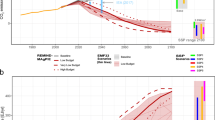Abstract
The magnitude and character of the global resource base of fossil fuels is a key determinant of the evolution of the future global energy system and corresponding fossil fuel carbon emissions. What is less well understood is the potential magnitude of impact of the availability of fossil fuels, due to the interaction with biomass energy, on agriculture, land use, ecosystems and therefore carbon emissions from land-use change. This paper explores these links and implications. We show that if oil resources are limited, then the consequently higher price for liquids induces both the use of coal-to-liquids technology deployment, but also enhanced production of bioenergy crops particularly in a business-as-usual scenario. This in turn implies greater pressure to convert unmanaged ecosystems to produce bioenergy, and higher rates of terrestrial carbon emissions from land use.







Similar content being viewed by others
Notes
1 Zettajoule = 1021 Joules
Within each region, crop and bioenergy expansion displaces forests and other ecosystems at different rates depending on a number of factors, including the initial extent of each ecosystem in the region and the perceived value of those ecosystems.
The policy imposed in this paper applies a uniform price on carbon to all regions of the world beginning in 2015. The price is adjusted to ensure that the target of 550 ppmv CO2-e is not exceeded at any point in time. The price applies to emissions of CO2 in the energy and industrial system, as well as to emissions of Kyoto gases in all sectors of the economy.
References
Bruinsma J (2009) The resource outlook to 2050: by how much do land, water, and crop yields need to increase by 2050? Expert meeting on how to feed the world in 2050. Food and Agriculture Organization of the United Nations
Chum H, Faaij A, Moreira JR, Berndes G, Dharnija P, Dong H, Gabrielle B, Goss Eng A, Lucht W, Mapako M, Masera Cerutti O, McIntyre T, Minowa T, Pingoud K (2011) Bioenergy. In: Edenhofer O, Pichs-Madruga R, Sokona Y, Seyboth K, Matschoss P, Kadner S, Zwickel T, Eickemeier P, Hansen G, Schlomer S, von Stechow C (eds) IPCC Special Report on Renewable Energy Sources and Climate Change Mitigation. Cambridge University Press, Cambridge, United Kingdom and New York, NY, USA
Clarke L, Kim SH, Edmonds JA, Dooley J (2007) Model Documentation for the MiniCAM Climate Change Science Program Stabilization Scenarios: CCSP Product 2.1a. PNNL Technical Report. PNNL-16735
Edmonds J, Reilly J (1985) Global energy: assessing the future. Oxford University Press, New York
Havlik P, A S, Schmid E, Bottcher H, Fritz S, Skalsky R, Aoki K, de Cara S, Kindermann G, Kraxner F, Leduc S, McCallum L, Mosnier A, Sauer T, Obersteiner M (2011) Global land-use implications of first and second generation biofuel targets. Energy Policy 39:5690–5702.
Kim S, Edmonds J, Lurz J, Smith S, Wise M (2006) The ObjECTS: Framework for Integrated Assessment: Hybrid Modeling of Transportation. Journal Name: The Energy Journal, (Special Issue No. 2 2006):63
Kriegler E, Mouratiadou I, Brecha R, Calvin K, de Cian E, Edmonds J, Jiang K, Luderer G, Tavoni M, Edenhofer O (2013) Will economic growth and fossil fuel scarcity help or hinder climate stabilization? Overview of the RoSE multi-model study. Climatic Change
Mellilo J, Reilly J, Kicklighter D, Gurgel A, Cronin T, Paltsev S, Felzer B, Wang X, Sokolov A, Schlosser A (2009) Indirect emissions from biofuels: How important? Science 326:1397–1399
Monfreda C, Ramankutty N, Hertel T (2009) Global agricultural land use data for climate change analysis. In: Hertel T, Rose S, Tol R (eds) Economic analysis of land use in global climate change policy. Routledge
Nakicenovic N et al (2000) IPCC Special Report on Emissions Scenarios. Cambridge University Press, Cambridge
Popp A, Krause M, Dietrich JP, Lotze-Campen H, Leimbach M, Beringer T, Bauer N (2012) Additional CO2 Emissions from land use change - forest conservation as a precondition for sustainable production of second generation bioenergy. Ecol Econ 74:64–70
Wise M, Calvin K (2011) GCAM 3.0 Agriculture and land use: technical description of modeling approach. Pacific Northwest National Laboratory, Richland, WA
Wise M, Calvin K, Thomson A, Clarke L, Bond-Lamberty B, Sands R, Smith SJ, Janetos A, Edmonds J (2009) Implications of limiting CO2 concentrations for land use and energy. Science 324:1183–1186
Acknowledgments
The authors are grateful for research support provided by Stiftung Mercator (www.stiftung-mercator.de). The authors also wish to express appreciation to the Integrated Assessment Research Program in the Office of Science of the U.S. Department of Energy for long-term support that enabled the development of the Global Change Assessment Model, which was used in the conduct of this research. This research also used Evergreen computing resources at the Pacific Northwest National Laboratory’s Joint Global Change Research Institute at the University of Maryland in College Park, which is supported by DOE SC-IARP.
Author information
Authors and Affiliations
Corresponding author
Additional information
This article is part of a Special Issue on “The Impact of Economic Growth and Fossil Fuel Availability on Climate Protection” with Guest Editors Elmar Kriegler, Ottmar Edenhofer, Ioanna Mouratiadou, Gunnar Luderer, and Jae Edmonds.
Electronic supplementary material
Below is the link to the electronic supplementary material.
Figure S1
The High, Medium, and Low curves are the supply curves input into GCAM (labeled “Input”). The four BAU curves are the cumulative production/price mappings that result from the scenarios (labeled “Output”). Input costs and output prices differ due to the inclusion of transportation and other costs in the output price. (DOC 147 kb)
Figure S2
Total Global Fossil Fuel Production in the BAU Scenarios (DOC 64 kb)
Figure S3
Cropland and Bioenergy Land by Aggregate Region in the BAU Scenarios (DOC 162 kb)
Rights and permissions
About this article
Cite this article
Calvin, K., Wise, M., Luckow, P. et al. Implications of uncertain future fossil energy resources on bioenergy use and terrestrial carbon emissions. Climatic Change 136, 57–68 (2016). https://doi.org/10.1007/s10584-013-0923-0
Received:
Accepted:
Published:
Issue Date:
DOI: https://doi.org/10.1007/s10584-013-0923-0




